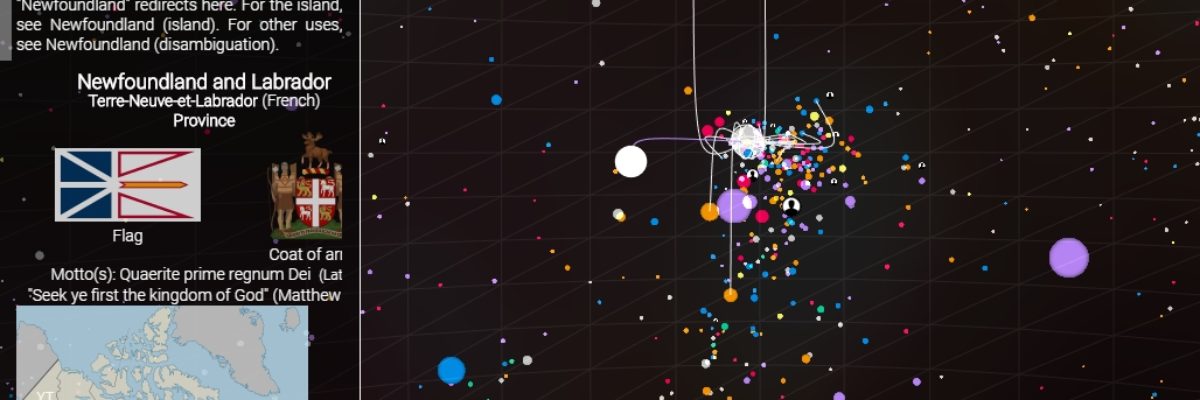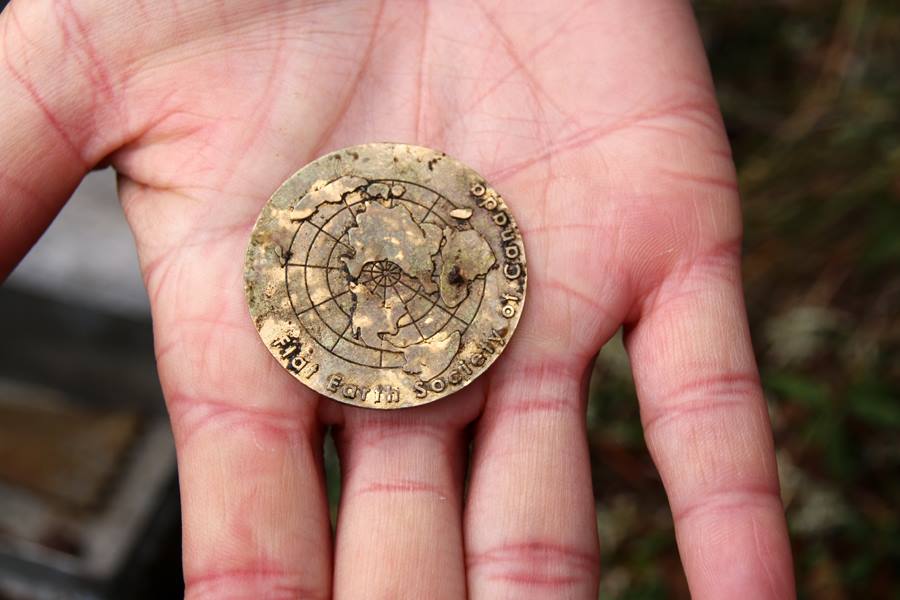What Links Here? Part 3 of a Wikipedia Series
January 2020
By Jenny Higgins
The pursuit of knowledge is not linear and tidy. It is a beautiful tangle that sprawls out in every which way: forever searching, forever pulling you in different directions. I touched on this a bit in my last article for NQ Online, “From Newfoundland and Labrador to Sam Spade: A Wikipedia Travelogue.” In it, I documented an hour or so I spent reading the online encyclopedia, beginning with “The History of Newfoundland and Labrador” and ending six clicks later at “Sam Spade.” All I did was follow the blue links that interested me in each article, meaning that every article I read was in some way connected to the previous and subsequent ones.
We’ve all fallen down the Wikipedia rabbit hole, but real research is like that, too. You begin with a central topic or question, then you follow your nose in libraries, archives, museums, and anywhere else the trail takes you. It can be shocking how messy a deceptively simple research question can become. One idea leads to another and another and another.
It’s a bit like getting lost in a web: everything is interconnected and there are a multitude of pathways enticing the researcher. But that visualization is a bit too simple, too two dimensional. Consider instead a galaxy of information we must navigate our way through. That’s what the French AI researcher, engineer, and artist Owen Cornec did in 2014 when he launched WikiGalaxy (http://wiki.polyfra.me/#), an interactive star map of Wikipedia.
“WikiGalaxy is a 3D web experiment that visualizes Wikipedia as a galactic web of information,” writes Cornec on the website’s homepage. “With it I aim to show the world the beauty and variety of knowledge that is available at our fingertips. I used 100,000 of 2014’s most popular articles, all clustered with hyperlinks. In this world Wikipedia articles are stars, interests are nebulas, and you are on a journey through knowledge.”
It’s a visually stunning galaxy, alight with a multitude of brightly coloured nimbus representing the different categories: history, society, culture, technology, language, and so on. Zooming in takes you to the stars and the individual articles.
Although the WikiGalaxy only contains 100,000 of English Wikipedia’s more than five million articles, there is a star for Newfoundland and Labrador. I located it deep inside the WikiGalaxy by using the search engine. Nearby stars represent closely related articles; they include “Alberta,” “Geography of Canada,” “Cape Breton Island,” “Culture of Canada,” and “Atlantic Canada.”
The WikiGalaxy does a clever and engaging job of showing the complex interconnections between different Wikipedia articles and, by extension different subjects in general. Locate any one article in the galaxy, and you can see the other articles that are in some way connected to it, sometimes with surprising results. But what would it look like if all five million articles were included? What else would connect with Newfoundland and Labrador?
Wikipedia itself allows the reader to discover this through a little-known tool called “What links here.” It can be found in the column of links that appear to the left of almost every Wikipedia article. Click it and you’ll be taken to a list of the other Wikipedia articles that link to the one you’re reading. “What links here” is not as pretty as the WikiGalaxy, but it can give you fresh insight into any given topic.
Thousands of articles link to Wikipedia’s main page about Newfoundland and Labrador. Scanning the list offers a glimpse of the many connections that exist between this province and the rest of the world. Many of the links are not surprising and duplicate those in the WikiGalaxy, like “Alberta” and “Geography of Canada.”
But there are also a lot that spark my curiosity. One is “Alexander Graham Bell.” I visit the article and read that Bell’s father had “suffered a debilitating illness earlier in life and had been restored to health by a convalescence in Newfoundland.” Under “Geography of Morocco” and “Geography of Finland,” I learn that Newfoundland and Labrador is slightly smaller than the former country and slightly larger than the latter. Wikipedia’s article about Pepsi reveals that Coca-Cola outsells Pepsi in almost all areas of the world, except for a few locations, including Newfoundland and Labrador.
Other food entries also draw my eye, including “Fried dough,” “Blood sausage,” and, intriguingly, “Apple bobbing.” The last article states that apple bobbing is a game often played at Halloween and is known as Snap Apple Night in Newfoundland and Labrador. I remember bobbing for apples as a child on Halloween (and tragically messing up my space alien face paint one year), but I have no recollection of anyone calling it Snap Apple Night. A quick Google search brings me to the Intangible Cultural Heritage Blog, where I read that: “There are several Halloween customs in Newfoundland and Labrador and this annual celebration has gone by many names, such as Snap-apple Night, Colcannon Night, or the Eve of All Saints’ Day.”
I return to Wikipedia, where I see (with a pang of delight) that “Fairy” also appears among the list of articles linking to Newfoundland and Labrador. “In Newfoundland folklore,” it states, “the most popular type of fairy protection is bread, varying from stale bread to hard tack or a slice of fresh homemade bread.” At the end of the long article is an external link to the Internet Archive, where you can listen to a three-minute recording of “The House on the Fairy Path,” a traditional folktale from the Southern Shore.
Wikipedia’s article about the Will-o’-the-wisp also links to Newfoundland and Labrador: “The names will-o’-the-wisp and jack-o’-lantern are explained in etiological folk-tales, recorded in many variant forms in Ireland, Scotland, England, Wales, Appalachia, and Newfoundland. In these tales, protagonists named either Will or Jack are doomed to haunt marshes with a light for some misdeed.”
Our province also appears on various lists, including Wikipedia’s “List of reported UFO sightings” (at Harbour Mille in 2010) and its “List of major power outages.” I also find a tantalizing link to a list called “Wikipedia: Unusual articles.” This page is worth visiting for many reasons unrelated to Newfoundland and Labrador, but this province appears there because of an article about the ugly stick. A cheeky editor added it with the following note: “an instrument in Newfoundland, an insult everywhere else.”
Thousands of other articles also link to Newfoundland and Labrador, including: “Atlantic puffin,” “Heather Mills,” “Fiddle,” “Fort McMurray,” “Circle K,” “April Wine,” “Society for Creative Anachronism,” “Old-time music,” and “Capelin.” It’s a seemingly interminable mish-mash of topics, which provide an eclectic overview of the people, places, events, flora, fauna, and miscellanea connected to Newfoundland and Labrador; together they trace out a strange and entertaining picture of how this province fits into the world.
Jenny Higgins, MUN’s Wikipedian-in-residence, is also a researcher and award-winning author whose most recent book, Agnes Ayre’s ABCs of Amazing Women, was published by Boulder Books.



